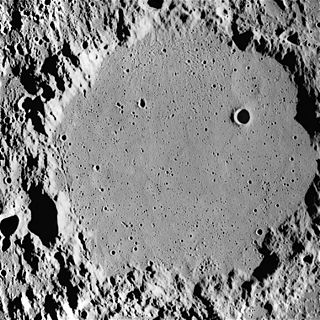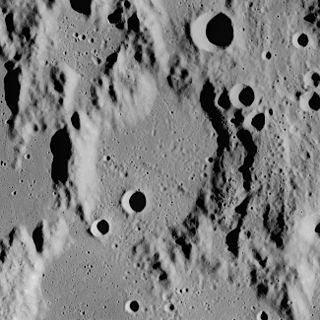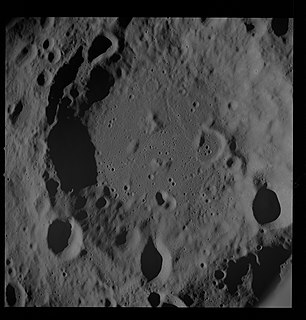
Arzachel is a relatively young lunar impact crater located in the highlands in the south-central part of the visible Moon, close to the zero meridian. It lies to the south of the crater Alphonsus, and together with Ptolemaeus further north the three form a prominent line of craters to the east of Mare Nubium. The smaller Alpetragius lies to the northwest, and Thebit is to the southwest along the edge of the mare.

Ptolemaeus is an ancient lunar impact crater close to the center of the near side, named for Claudius Ptolemy, the Greco-Roman writer, mathematician, astronomer, geographer and astrologer. It measures approximately 154 kilometers in diameter.

Müller is a lunar impact crater. It was named after Austrian astronomer Karl Müller. It is located in the highlands near the center of the Moon, in the center of the triangle formed by the much larger craters Albategnius, Ptolemaeus, and Hipparchus. To the east lies Halley, while to the northwest is Gyldén.

Bohnenberger is a lunar impact crater that lies near the east edge of the Mare Nectaris, in the foothills of the Montes Pyrenaeus mountain range that forms the perimeter of the mare. To the east beyond the mountains is the larger crater Colombo. The crater has a low rim along the north wall, and the floor is somewhat irregular with a ridge crossing the floor. There is a small crater along the western inner wall.

Herschel is a lunar impact crater located just to the north of the walled plain Ptolemaeus. Its diameter is 39 km. It was named after German-born British astronomer William Herschel.

Réaumur is the remains of a lunar impact crater located on the southern edge of Sinus Medii. Its diameter is 51 km. It was named after the 18th century French scientist René de Réaumur. It shares an eroded rim with the similar crater Oppolzer to the northwest. It lies to the northwest of the large walled plain Hipparchus, and east of Flammarion. To the south is Gyldén, and farther to the south-southwest is Ptolemaeus.

Palisa is the remnant of a lunar impact crater that is located to the west of the walled plain Ptolemaeus. It lies to the north-northeast of the crater Davy, and is attached to the lava-flooded satellite crater Davy Y by a wide break in the southwest rim. The crater is named after the Austrian astronomer Johann Palisa.

Becquerel is a lunar impact crater that lies in the northern hemisphere on the far side of the Moon. This is an ancient and heavily worn formation that is now little more than an irregular buri in the surface. The outer rim has been worn and reshaped until it forms a rugged, mountainous region around the flatter interior.

Desargues is an ancient lunar impact crater that is located near the northern limb of the Moon, on the western hemisphere. It lies nearly due south of the crater Pascal, and southeast of Brianchon. The proximity of this crater to the limb means that it appears highly elongated due to foreshortening, and it is difficult to discern details from the Earth.

Barringer is a lunar impact crater that is located on the southern hemisphere on the Far side of the Moon, named after geologist Daniel Barringer. It is attached to the north-northeastern rim of the walled basin named Apollo, and lies to the southeast of Plummer. South of Barringer, on the floor of the Apollo basin, is the crater Scobee.

Cusanus is a lunar impact crater that is located near the northeastern limb of the Moon. In this location the crater appears very foreshortened when observed from the Earth, and its visibility is affected by libration. The northern rim of Cusanus is nearly joined to the south-southeastern rim of the larger crater Petermann. To the west is Baillaud and to the southeast is Hayn.

Casatus is a lunar impact crater that is located near the southern limb of the Moon. The north-northeast rim of the crater overlies a portion of the slightly larger crater Klaproth. Along the western rim, Casatus A intrudes somewhat into the interior, producing an inward-bowing rim. To the southeast of Casatus is Newton.

Bliss is small lunar impact crater that is located just to the west of the dark-floored crater Plato. It lies in a region of continental terrain between Mare Imbrium to the south and Mare Frigoris to the north. This crater is bowl-shaped, with a small interior floor at the midpoint and a somewhat eroded outer rim.

Coriolis is a lunar impact crater that is located on the far side of the Moon. The crater floor is bisected by the lunar equator, and it lies about three crater diameters northwest of the crater Daedalus.

Comstock is a lunar impact crater that is located on the far side of the Moon. It lies to the northeast of the walled plain Fersman, and north of the crater Weyl.

Gyldén is the remnant of a lunar impact crater that is located to the northeast of the walled plain Ptolemaeus on the Moon. Its diameter is 48 km. It is named after the Finland-Swedish astronomer Hugo Gyldén. It lies along the prime meridian of the selenographic coordinate system, and less than 150 km south of the lunar equator. Nearby craters of note include Herschel to the west, the flooded Réaumur to the north, and Hipparchus to the east.

Douglass is a lunar impact crater on the far side of the Moon. It lies to the southwest of the crater Frost and south-southwest of the large walled plain Landau.

Dziewulski is a lunar impact crater on the far side of the Moon. It lies between the craters Edison to the north and Popov to the south. The outer rim of this crater has been considerably worn by impacts, particularly along the southwest quadrant where the satellite crater Dziewulski Q overlies the rim and the interior floor. The northern rim is also heavily disrupted, and several small crater lie along the southeast rim. The interior floor and surrounding terrain has been resurfaced.

Fleming is a large lunar impact crater that is located on the Moon's far side, and cannot be seen from the Earth. It lies about a crater diameter to the east-northeast of Hertz, and to the northwest of Lobachevskiy.

Fridman is the remains of a lunar impact crater on the far side of the Moon. It lies due south of the huge walled plain Hertzsprung, and is attached to the northeastern rim of the crater Ioffe.






















